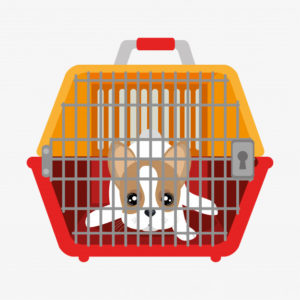Why Crate Train Your Puppy?
Crate Training is important because dogs need support, structure, and safety to flourish. Being in the center of attention is fun until the object of that attention is overstimulated and bewildered. The crate becomes a valuable tool for successfully integrating the dog into the house. Here we will discuss:
- Choosing a crate
- Teaching the dog
- Using crates for structure
- Finding balance
Crate Training your dog:
Set the crate up in the area it will be kept. Ideally this is not a place to be excluded from social interaction, but a place to decompress. This can be the bedroom, living room, or even both! Going to the crate should not be punishment, so help your dog explore this new feature by dropping treats and serving meals in the crate with the door open.
- Make the crate comfortable with a crate pad, towel, or mat(be aware of your dog’s chew style when choosing what to place inside).
- Reward your dog every time he goes inside.
- Until the dog is very relaxed with the crate, do not close the door.
- Place an appropriate chew toy inside for entertainment.
Using Crates for Structure:
Being given endless choices is bewildering and exhausting. It is also important for the human guardians to recognize when they need a break (we all do). By using a crate for breaks and quiet time, dogs can stop looking for adventure (aka trouble) and just chew on their toy or take a nap. This can also prevent unwanted behaviors when we cannot provide direct supervision. It is far easy to prevent behaviors than it is to retrain them!
- If your dog has gotten mental and physical stimulation appropriate for the age, but isn’t settling down, your pup may be overstimulated. It’s ok to give your pup a chance to nap.
- Putting newer members of the household in a crate when you are asleep or absent can prevent potty messes or inappropriate chewing.
- Trained properly, the crate should be a safe place of retreat if needed. Leave the door open for choice!
- Set up a routine that helps the new dog learn what to expect.
Finding Balance:
Any tool can be used for good or ill. Before crating our dogs, it is important to ensure they have had physical and mental stimulation. Offer your dog the opportunity to potty outside before and after crating to encourage good potty habits(they don’t want to poop where they sleep but if nature calls, he may not have a choice). Meet your dog’s social needs with the attention they crave so that the crate really is just a place to decompress. If you crate at night, make sure you meet your dog’s needs immediately upon getting up.
- If you know you’ll be gone an extended time, consider a dog walker or coming home at lunch for a break.
- Some dogs prefer to have their crate covered for a safe dark space, others prefer to see what is going on.
- Crating can offer a place to get away from it all.
- Enrichment in the crate can prevent boredom.
For another perspective, check out advice from the Karen Pryor Academy!

